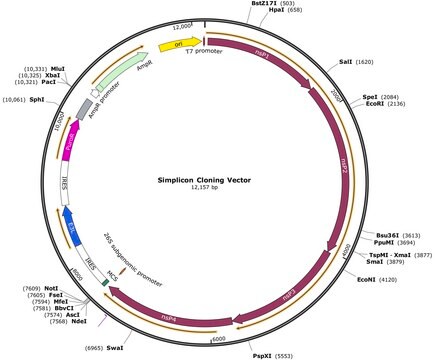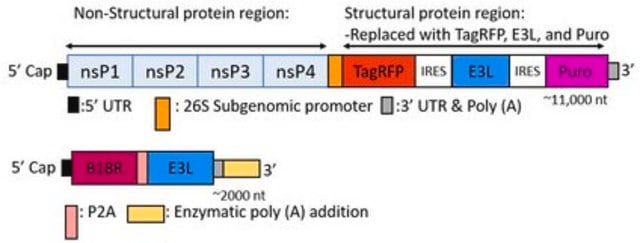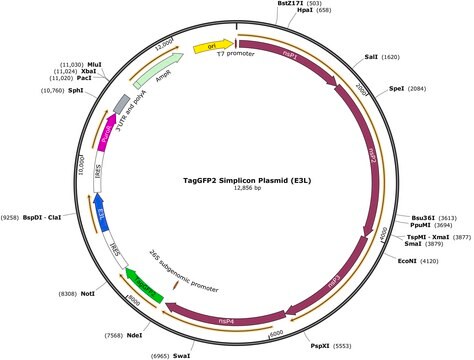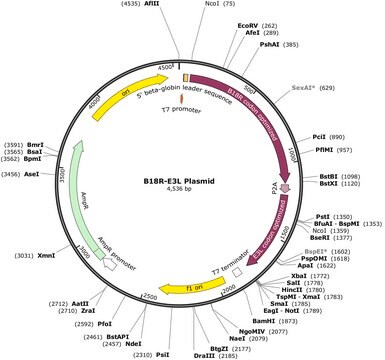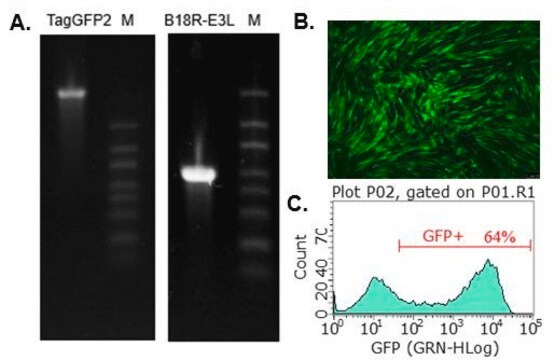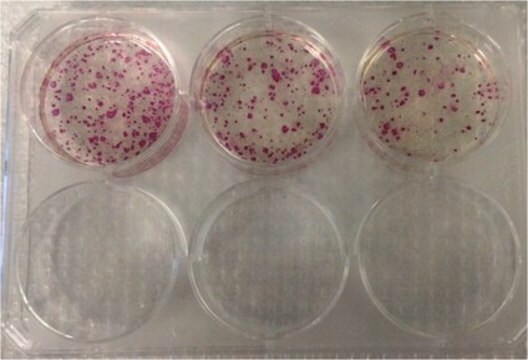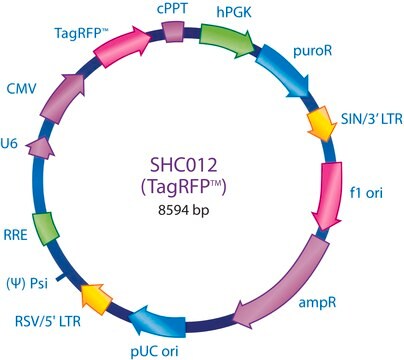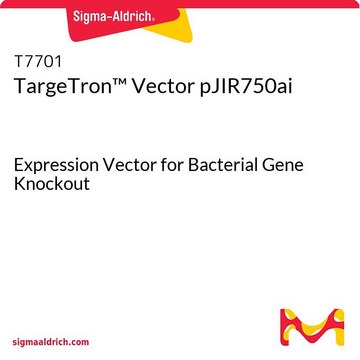SCR726
Plasmide TagRFP Simplicon® (E3L)
Se connecterpour consulter vos tarifs contractuels et ceux de votre entreprise/organisme
About This Item
Code UNSPSC :
12352207
eCl@ss :
32161000
Nomenclature NACRES :
NA.51
Produits recommandés
Technique(s)
nucleic acid detection: suitable (RNA)
Conditions d'expédition
ambient
Description générale
Simplicon is a novel system to effect immediate high sustained protein expression of multiple genes into transfected cells without the risk of genome integration. The technology employs a single, synthetic, polycistronic, self-replicating RNA based on the Venezuelan equine encephalitis (VEE) genome1,2,3,4. The Simplicon RNA contains only genes encoding the VEE RNA replication machinery while the structural proteins that are required to make an infectious particle have been removed and replaced with the transgenes of interest. The Simplicon RNA is a synthetic RNA generated from the SimpliconTM Cloning Vector (E3L) plasmid.
Introduction and replication of the Simplicon RNA is expected to elicit a strong interferon response in transfected cells. To suppress the IFN responses, a Vaccinia virus protein5, B18R, is used for the original SimpliconTM technology. Recently, we found that another Vaccinia virus protein5, E3L, also suppresses the IFN responses in Simplicon RNA expression. B18R neutralizes type I interferons by direct binding, while E3L inhibits the cytoplasmic signaling pathways of IFN responses. Therefore, B18R and E3L are both employed in the Simplicon Expression System and work collaboratively to suppress IFN responses. As a result, there is increased cell viability during RNA transfection and increased expression of the transgenes. The Simplicon Expression System works in human cells and is not expected to work in mouse cells. This is because the B18R does not effectively neutralize mouse interferon (IFN)-β.
One day after transfection of the Simplicon RNA, a spike in the levels of transgenes can be observed. The expression levels are maintained by addition of B18R, E3L and the selective agent, puromycin throughout the duration of the experiment. Over time, expression levels are expected to diminish and stabilize to 1/5 – 1/10 the levels initially observed and may be close to physiological levels after one week. Expression levels and duration may change depending upon the cell types, transgenes and media conditions used. The Simplicon technology has been successfully utilized for efficient human iPSC generation through the sustained expression of critical reprogramming factors3,4 and in the creation of cell lines that express and retain the metabolic activities of five cytochrome P450 enzymes6.
In the Simplicon Expression System, B18R and E3L are provided as a B18R-E3L RNA (Cat. No. SCR722) for the suppression of IFN responses at RNA transfection. For sustained transgene expression, recombinant B18R protein (Cat. No. SCR156 and SCR197) or B18R conditioned medium (B18R-CM) can be used. E3L is continuously provided from the Simplicon RNA itself. B18R-CM can be produced from B18R-E3L RNA or B18R RNA synthesized using the B18R-E3L plasmid (Cat. No. SCR727) or B18R plasmid (Cat. No. SCR728), respectively.
The TagRFP Simplicon Plasmid (E3L) was developed for the synthesis of TagRFP Simplicon RNA (E3L). The Simplicon TagRFP RNA may be used to determine optimal transfection conditions to express the self-replicating RNA in hard-to transfect somatic or primary cells. Simplicon TagRFP expresses a monomeric red (orange) fluorescent protein generated from the RFP of sea anemone Entacmaea quadricolor. TagRFP exhibits fluorescence with excitation/emission maxima at 555/584 nm respectively, and brightness that is nearly three times higher than mCherry7,8.
Introduction and replication of the Simplicon RNA is expected to elicit a strong interferon response in transfected cells. To suppress the IFN responses, a Vaccinia virus protein5, B18R, is used for the original SimpliconTM technology. Recently, we found that another Vaccinia virus protein5, E3L, also suppresses the IFN responses in Simplicon RNA expression. B18R neutralizes type I interferons by direct binding, while E3L inhibits the cytoplasmic signaling pathways of IFN responses. Therefore, B18R and E3L are both employed in the Simplicon Expression System and work collaboratively to suppress IFN responses. As a result, there is increased cell viability during RNA transfection and increased expression of the transgenes. The Simplicon Expression System works in human cells and is not expected to work in mouse cells. This is because the B18R does not effectively neutralize mouse interferon (IFN)-β.
One day after transfection of the Simplicon RNA, a spike in the levels of transgenes can be observed. The expression levels are maintained by addition of B18R, E3L and the selective agent, puromycin throughout the duration of the experiment. Over time, expression levels are expected to diminish and stabilize to 1/5 – 1/10 the levels initially observed and may be close to physiological levels after one week. Expression levels and duration may change depending upon the cell types, transgenes and media conditions used. The Simplicon technology has been successfully utilized for efficient human iPSC generation through the sustained expression of critical reprogramming factors3,4 and in the creation of cell lines that express and retain the metabolic activities of five cytochrome P450 enzymes6.
In the Simplicon Expression System, B18R and E3L are provided as a B18R-E3L RNA (Cat. No. SCR722) for the suppression of IFN responses at RNA transfection. For sustained transgene expression, recombinant B18R protein (Cat. No. SCR156 and SCR197) or B18R conditioned medium (B18R-CM) can be used. E3L is continuously provided from the Simplicon RNA itself. B18R-CM can be produced from B18R-E3L RNA or B18R RNA synthesized using the B18R-E3L plasmid (Cat. No. SCR727) or B18R plasmid (Cat. No. SCR728), respectively.
The TagRFP Simplicon Plasmid (E3L) was developed for the synthesis of TagRFP Simplicon RNA (E3L). The Simplicon TagRFP RNA may be used to determine optimal transfection conditions to express the self-replicating RNA in hard-to transfect somatic or primary cells. Simplicon TagRFP expresses a monomeric red (orange) fluorescent protein generated from the RFP of sea anemone Entacmaea quadricolor. TagRFP exhibits fluorescence with excitation/emission maxima at 555/584 nm respectively, and brightness that is nearly three times higher than mCherry7,8.
Application
Le plasmide TagRFP Simplicon (E3L) a été mis au point pour permettre l'évaluation du système d'expression Simplicon dans votre ou vos lignées cellulaires. Vous pouvez par exemple l'utiliser pour identifier les conditions de transfection optimales pour l'expression de votre ARN autoréplicatif d'intérêt au moyen du vecteur de clonage Simplicon (E3L) (réf. SCR724) dans des cellules primaires ou somatiques difficiles à transfecter.
Stockage et stabilité
Plasmide TagRFP Simplicon™ (E3L) (réf. SCR726). Un (1) flacon contenant 10 µl de plasmide (1 µg/µl). À conserver à -20 °C.
Autres remarques
Concentration : voir la fiche technique du lot concerné.
Informations légales
SIMPLICON is a registered trademark of Merck KGaA, Darmstadt, Germany
Clause de non-responsabilité
Sauf indication contraire dans notre catalogue ou toute autre documentation associée au(x) produit(s), nos produits sont uniquement destinés à la recherche et ne sauraient être utilisés à d'autres fins, ce qui inclut, sans s'y limiter, les utilisations commerciales non autorisées, les utilisations diagnostiques in vitro, les utilisations thérapeutiques ex vivo ou in vivo, ou tout type de consommation ou d'application chez l'être humain ou chez l'animal.
Code de la classe de stockage
12 - Non Combustible Liquids
Certificats d'analyse (COA)
Recherchez un Certificats d'analyse (COA) en saisissant le numéro de lot du produit. Les numéros de lot figurent sur l'étiquette du produit après les mots "Lot" ou "Batch".
Déjà en possession de ce produit ?
Retrouvez la documentation relative aux produits que vous avez récemment achetés dans la Bibliothèque de documents.
Notre équipe de scientifiques dispose d'une expérience dans tous les secteurs de la recherche, notamment en sciences de la vie, science des matériaux, synthèse chimique, chromatographie, analyse et dans de nombreux autres domaines..
Contacter notre Service technique